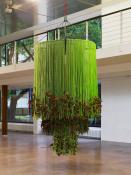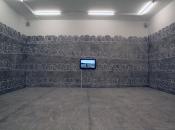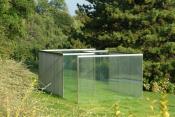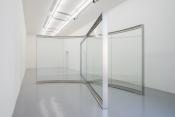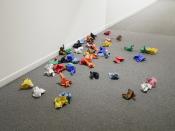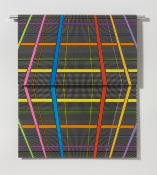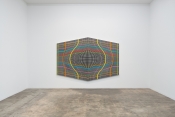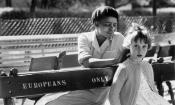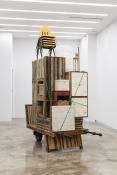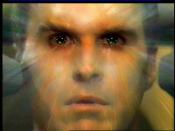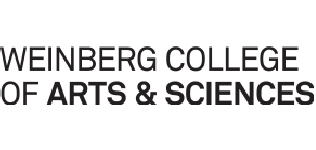Andrea Bowers,
2008
Born in 1965 in Wilmington, OH, Andrea Bowers lives and works in Los Angeles. Bowers’ work has been featured in solo exhibitions at the Wiener Secession, Vienna; The Power Plant, Toronto; Pitzer College Art Galleries and Pomona College Museum of Art, Claremont, CA; Tang Museum, Skidmore College, Saratoga Springs, NY; REDCAT, Los Angeles; Zentrum für Kunst und Medientechnologie, Karlsruhe, Germany; and National Museum of Contemporary Art, Athens, Greece. She recently collaborated with Suzanne Lacy on a 10-day performance and installation at the Drawing Center, New York.
Bowers’ work was selected for the SITE.lines Biennial 2014 at SITE Santa Fe, Santa Fe, NM; 2014 Gwangju Biennial, Gwangju, South Korea; and 2004 Whitney Biennial, New York. Her work has been included in group exhibitions at the Louisiana Museum of Modern Art, Humlebaek, Denmark; Stedeljik Museum voor Actuele Kunst, Ghent, Belgium; Museum of Modern Art, New York; New Museum, New York; Museum of Contemporary Art, Los Angeles; Walker Art Center, Minneapolis, MN; Hammer Museum, Los Angeles; Yerba Buena Center for the Arts, San Francisco; Museum of Contemporary Art, Detroit, MI; Museum of Contemporary Art, San Diego, CA; and Museum of Contemporary Art, Sydney, Australia. She is represented by Susanne Vielmetter Los Angeles Projects and Andrew Kreps Gallery, New York.
Dan Graham,
2008
Since the mid-1960s, Dan Graham has produced an important body of art and theory that engages in a highly analytical discourse on the historical, social and ideological functions of contemporary cultural systems. Architecture, popular music, video and television are among the focuses of his provocative investigations, which are articulated in essays, performances, installations, videotapes and architectural/sculptural designs. Graham has published numerous critical essays, and is the author of Video-Architecture-Television (1980).
Graham's work is represented in the collections of numerous major institutions in the United States and Europe, including Moderna Museet, Stockholm; Centre Pompidou, Paris; and Tate Gallery, London. He has had solo exhibitions at the Museum of Contemporary Art, Los Angeles; Castello di Rivoli, Museo d' Arte Contemporanea, Turin, Italy; Whitney Museum of American Art, New York; Walker Art Center, Minneapolis, Minnesota; Van Abbemuseum, Eindhoven, Holland; Museum of Modern Art, Oxford, England; The Renaissance Society, University of Chicago; Kunsthalle, Berne, Switzerland; and the Art Gallery of Western Australia, Perth; and has been represented internationally in group exhibitions at Documenta 7, Kassel, Germany; Art Institute of Chicago; Stedelijk Museum, Amsterdam; P.S. 1, New York; Marion Goodman Gallery, and The Museum of Modern Art, New York, among other institutions.
Tom Marioni,
2008
Marioni was born in 1937 in Cincinnati, Ohio, attended the Cincinnati Art Academy, and in 1959 moved to San Francisco where he still lives. His first sound work, One Second Sculpture (1969) was celebrated in the 2005 Lyon Biennial as presaging the work of many artists today who use sound and duration as subjects. His first museum show was in 1970 at the Oakland Museum of California. Titled The Act of Drinking Beer with Friends Is the Highest Form of Art, it was an early example of social activity as art. Over the years, Marioni has been invited to repeat the work in various contexts around the world.
Marioni was included in important sound art shows: For Eyes and Ears (1980) at the Academy of Fine Arts in Berlin, Live to Air (1982) at the Tate Gallery in London, and From Sound to Image (1985) at the Stuttgart Staatsgalerie in Germany. His work was shown in Out of Actions: Between Performance and the Object in 1998, organized by the Museum of Contemporary Art in Los Angeles. Drawing is central to Marioni’s art, and in 1999 he had a drawing retrospective at the Mills College Art Museum in Oakland. His prints have been published by Crown Point Press since 1974. In 2006 the Contemporary Arts Center in Cincinnati presented a survey exhibition of his work since 1968. Marioni was included in The Art of Participation: 1950 to Now, in 2008 at the San Francisco Museum of Modern Art and The Third Mind: American Artists Contemplate Asia, 1860-1989 in 2009 at the Guggenheim Museum, New York. His work is in the collections of the San Francisco Museum of Modern Art, the Museum of Modern Art in New York, the Stadtische Kunsthalle in Mannheim, Germany, and other museums. He is represented by Anglim Gilbert Gallery in San Francisco and Margarete Roeder Gallery in New York.
Fritz Haeg,
2008
Fritz Haeg applies his skills as an architect to diverse artistic and curatorial practices that include designing houses, leading a peripatetic educational center, facilitating grassroots political activism, and experimenting in radical gardening. Rejecting categorization and specialization, Haeg is attracted to multidisciplinary projects that manifest as social opportunities, benevolent gestures, or inspirational models. Haeg takes a collective approach to his work, viewing its outcomes as organic culminations of multiple individual inputs rather than the result of directorial cues.
Linda Besemer,
2009
Linda Besemer explores the plasticity and physicality of painting. Spilling from aluminum rods affixed to gallery walls are dried sheets of two-sided patterned acrylic paint. Referencing critical theory, feminism, objecthood, decoration and finish fetish, Besemer’s paintings question the forms and underlying signifying practices of modernism, abstraction and the two-dimensionality of the medium. Besemer’s paintings have been featured in numerous museums, most notably: The Whitney Museum of American Art, The Corcoran Museum of Contemporary Art, The Los Angeles County Museum of Art, The Albright Knox Museum, the Aldrich Museum of Contemporary Art, The South Eastern Center for Contemporary Art, Grand Arts Center for Contmeporary Arts, SITE, Sante Fe, Weatherspoon Museum of Art, and The Palm Beach ICA. She is also exhibiting internationally in Europe and Mexico.
Peter Magubane,
2009
Dr Magubane embarked on his long and distinguished career in 1955, when he joined Drum magazine.This took Magubane and his camera to the heart of the anti-apartheid defiance campaigns and treason trials. After the Drum years, he travelled and exhibited in Europe, and spent time studying in the United States and on his return in 1966 joined the Rand Daily Mail.In 1969, he was detained for 586 day in solitary confinement, and after this, he was banned as a photographer for five years.He returned to his work in time to bear witness to the uprising of young school children that began on June 16, 1976.
He resumed work for the Rand Daily Mail. Coverage of the Soweto riots of 1976 earned him worldwide acclaim (e.g. 'The coffins of thirty of the Sharpeville dead were buried side by side', see Magubane's South Africa, p. 26) and led to a number of international photographic and journalistic awards, one of which was the American National Professional Photographers Association Humanistic Award in 1986, in recognition of one of several incidents in which he put his camera aside and intervened to prevent people being killed. He also took photographs for several United Nations agencies, including the High Commission for Refugees and UNICEF, being particularly committed to exposing the plight of children and documenting traditional societies. His photographs have appeared in Life magazine, the New York Times, National Geographic and Time.
Saul Ostrow,
2009
Saul Ostrow curated Working Digitally: no Websites Please (2001, 2005) at The Center For Visual Arts and Culture, University of Connecticut and Modeling the Photographic: The Ends of Photography (2006) for the McDonough Museum of Art located in Youngstown, Ohio. Both of these exhibitions examined the impact of digital technologies on current art practice and included internationally recognized artists: James Welling, Barbara Probst, Fabian Marcaccio, Joseph Nechvatal, Curtis Mitchell, Matthew Buckingham and Penelope Umbrico.
Saul Ostrow is the editor of the book series Critical Voices in Art, Theory and Culture published by Routledge London and is the Art Editor for Bomb Magazine. In a 2011 interview with Brian Sherwin for FineArtViews, Ostrow declared that art criticism is important because it helps to establish the concept of the "collective self". Ostrow suggested that criticism is important because it helps to address the "contradictions and dichotomies inherent in our social and cultural lives". In the interview Ostrow shared his experience as Art Editor for Bomb Magazine and his insight into the "changing landscape" of art criticism due to the advent of the Internet and art blogs. When asked about sexism, ageism, and racism within the contemporary art world Ostrow suggested that all three exist because all three exist in larger society.
Matt King,
2009
Matt King lives and works in Richmond, VA where he is Assistant Professor of Art Foundation and Sculpture + Extended Media, Virginia Commonwealth Univerisity, School of the Arts. “I’ve been thinking about the fleeting and often incongruous emotions that I experience while casually attending to the details of my life. These are moments of reflection that disrupt the seamlessness of my journey through the commercial corridors that make up so much of my concept of America. For example, a chance juxtaposition of objects might transform a dollar store into a repository of latent emotion, full of gifts and cleaning products. A pet store becomes a vast arena that promises nourishment and responsibility, a collision of biology and love. These boxy outlets are intoxicating. I find myself seduced by their offerings, queasy under their fluorescent lights, and thrilled when their unintended poetics stops me in my tracks.”
Theaster Gates,
2009
Theaster Gates has developed an expanded practice that includes space development, object making, performance and critical engagement with many publics. Founder of the non-profit Rebuild Foundation, Gates is currently a Professor in the Department of Visual Art and Director of Arts and Public Life at the University of Chicago. Gates has exhibited and performed at the Studio Museum in Harlem, New York; Whitechapel Gallery, London; Punta della Dogana, Venice; Museum of Contemporary Art, Chicago; Santa Barbara Museum of Art; and Documenta 13, Kassel, Germany; among others. Recent winner of Artes Mundi 6, Gates has also received awards and grants from Creative Time, the Vera List Center for Art and Politics, United States Artists, Creative Capital, the Joyce Foundation, Graham Foundation, Bemis Center for Contemporary Arts, and Artadia.
Mike Hoolboom,
2009
Mike Hoolboom is a Canadian artist working in film and video. He has made twenty films and videos which have appeared in over four hundred festivals, garnering thirty awards, including four awards in Oberhausen, a Golden Leopard at Locarno, and he has twice won the award for the best Canadian short at the Toronto International Festival. He has been granted two lifetime achievement awards, the first from the city of Toronto, and the second from the Mediawave Festival in Hungary.
He is a founding member of the Pleasure Dome screening collective and has worked as the artistic director of the Images Festival and as the experimental film co-ordinator at the Canadian Filmmakers Distribution Centre. Mike Hoolboom has written three non-fiction books, Practical Dreamers: Conversations with Canadian Movie Artists (Coach House, 2008), Inside the Pleasure Dome: Fringe Film in Canada (Coach House Press, 2001) and Plague Years (YYZ Books, 1998) a tongue-in-chic autobiography. His first novel The Steve Machine was published by Coach House Press in the fall of 2008. He has published more than one hundred articles on fringe media which have appeared in magazines and catalogues around the world.

